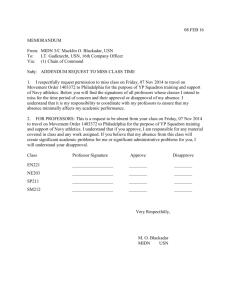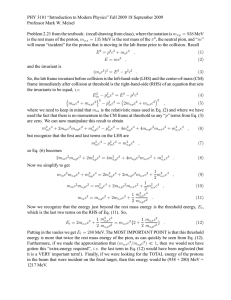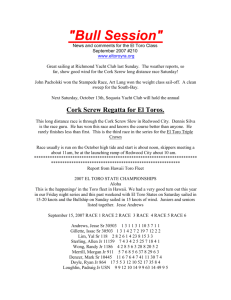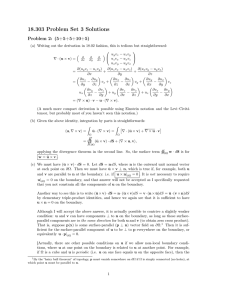Document 10779528
advertisement
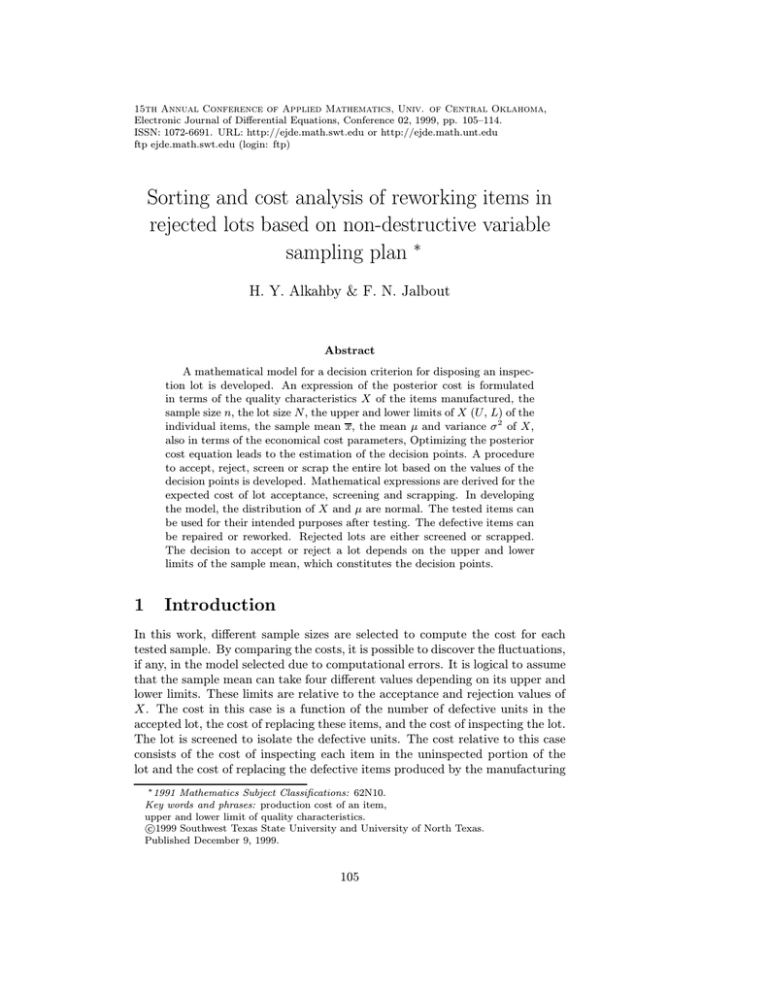
15th Annual Conference of Applied Mathematics, Univ. of Central Oklahoma, Electronic Journal of Differential Equations, Conference 02, 1999, pp. 105–114. ISSN: 1072-6691. URL: http://ejde.math.swt.edu or http://ejde.math.unt.edu ftp ejde.math.swt.edu (login: ftp) Sorting and cost analysis of reworking items in rejected lots based on non-destructive variable sampling plan ∗ H. Y. Alkahby & F. N. Jalbout Abstract A mathematical model for a decision criterion for disposing an inspection lot is developed. An expression of the posterior cost is formulated in terms of the quality characteristics X of the items manufactured, the sample size n, the lot size N , the upper and lower limits of X (U , L) of the individual items, the sample mean x, the mean µ and variance σ 2 of X, also in terms of the economical cost parameters, Optimizing the posterior cost equation leads to the estimation of the decision points. A procedure to accept, reject, screen or scrap the entire lot based on the values of the decision points is developed. Mathematical expressions are derived for the expected cost of lot acceptance, screening and scrapping. In developing the model, the distribution of X and µ are normal. The tested items can be used for their intended purposes after testing. The defective items can be repaired or reworked. Rejected lots are either screened or scrapped. The decision to accept or reject a lot depends on the upper and lower limits of the sample mean, which constitutes the decision points. 1 Introduction In this work, different sample sizes are selected to compute the cost for each tested sample. By comparing the costs, it is possible to discover the fluctuations, if any, in the model selected due to computational errors. It is logical to assume that the sample mean can take four different values depending on its upper and lower limits. These limits are relative to the acceptance and rejection values of X. The cost in this case is a function of the number of defective units in the accepted lot, the cost of replacing these items, and the cost of inspecting the lot. The lot is screened to isolate the defective units. The cost relative to this case consists of the cost of inspecting each item in the uninspected portion of the lot and the cost of replacing the defective items produced by the manufacturing ∗ 1991 Mathematics Subject Classifications: 62N10. Key words and phrases: production cost of an item, upper and lower limit of quality characteristics. c 1999 Southwest Texas State University and University of North Texas. Published December 9, 1999. 105 106 Sorting and cost analysis of reworking items facility. The cost of scrapping consists of the cost of each unit scrapped. The cost of scrapping items produced by the production facility is reduced by the revenue of the salvaged material. After reaching a decision on the rejected items that can be reworked, the cost of reworking these items is derived. In this process of screening, the expected value of the fraction of items that can be reworked is evaluated and used as a standard for future production. The work is concentrated on finding a set of upper and lower limits of the quality characteristic X, namely LA , UA , Lsn , Usn . A control chart is constructed based on these values to test the manufactured lots. Values of the sample mean above UA and below Usn , or below LA and above Lsn are screened. After screening the items produced, a decision can be made to scrap or rework the defective items found. The main advantage of this procedure are to: (1) reduce the cost due to penalty of producing defective items, (2) satisfy the needs of both the producers and consumers, who are seeking good products with a reasonable cost, (3) keep the quality of the items produced at a very high standard at any stage of production. 2 Mathematical development of the model In estimating the expected posterior cost of rejecting and reworking defective items the following assumptions are made: (1) The probability that an individual measurement is above or below the upper and lower specification limit when both the lot and the sample are considered. (2) The costs of accepting and repairing items with dimensions above or below the specification limits for both the lot and the sample are considered. (3) The screening errors of types I and II are negligible. (4) The process can exist in one statistical state. The components of the cost are: (A) Cost of Items Worked With or Without Success The cost per lot resulting from defective items found during inspection and reworked with and without success. Kw1 (x, µ), is then: Kw1 (x, µ) = Kc1 nP3s + Kc2 nP4s + [(KR − KJ )(1 − KY )]P3s +n[(KR − KJ )(1 − KY )]P4s , (1) where the symbols in this paper are defined in the Appendix. For the remainder of the lot the cost Kw2 (x, µ) is given as: Kw2 (x, µ) = Kc1 (N − n)P1u + Kc2 (N − n)P2L +(N − n)P1u [(KR − KJ )(1 − KY )] +(N − n)P1u [(KR − KJ )(1 − KY )] . (2) Assuming Kc1 = Kc2 = Kc and P1u = P2L , expression (1) can be written as Kw1 (x, µ) = n[Kc + (KR − KJ )(1 − KY )][P3s + P4s ] . (3) H. Y. Alkahby & F. N. Jalbout 107 Defining KR1 as KR1 = [Kc + (KR − KJ )(1 − KY )] , (4) and employing expression (4), then expressions (1) and (2) can be written respectively as: hZ KW 1 (x, µ) = nKR1 ∞ U Z t(x | x, µ) + and (N − n)KR1 KW 2 (x, µ) = hZ ∞ U L −∞ i t(x | x, µ) dx i hZ (f (x)µ) dx + L −∞ (5) i f (x | µ) dx X. (6) (B) Cost of Reworked Defective Items The expected cost, KW (x, µ), of reworking defective items success can be obtained by adding expressions (5) and (6), thus KW (x, µ) = N KR1 − nKR1 Q1D (x, µ) − (N − n)KR1 P1D (µ) . (7) where the two possibilities P1D (µ) and Q1D (x, µ) are defined in the following form: P1D (µ) = RU and Q1D (x, µ) = L RU L f (x | µ) dx , (8) t(x | x, µ) dx . (9) The total expected cost can be written as: "Z Z +∞ KT UA = −∞ Z −KAn LA +∞ n(KA − KP )Q1D (x, µ)T (xn | µ) dx h(µ) dµ "Z UA UL −∞ # P1D (µ)T (xn | µ) dx h(µ) dµ + (KA (N − n) + Kpn ) Z +∞ "Z Lsn + −∞ Z +∞ LA "Z Usn + −∞ # LA Z +∞ −∞ "Z UA UL # T (xn | µ) dx h(µ) dµ # KW (x, µ)T (xn | µ) dx h(µ) dµ # KW (x, µ)T (xn | µ) dx h(µ) dµ + KI n . (10) The decision points LA , UA , Lsn , Usn , relative to a lot acceptance and screening, respectively, are defined in the Appendix. For estimating the decision points, the total cost must be optimized relative to UA . Taking the partial derivative 108 Sorting and cost analysis of reworking items of KT relative to UA yields: ∂KT ∂UA Z = n(KAn − KP ) Z −KA N −N KR1 +∞ Z +nKR1 −∞ −∞ Q1D ((UA , µ)T (UA ) | µ) h(µ) dµ P1D (µ)T (UA | µ)h(µ) dµ −∞ Z +∞ −∞ +∞ +∞ T (UA | µ)h(µ) dµ Q1D (UA , µ)T (UA | µ)h(µ) dµ Z +(N − n)KR1 +∞ −∞ P1D (µ)T (UA | µ)h(µ) dµ . (11) Arranging the terms in expression (11) yields: Z ∂KT ∂UA = n [(KA − KP ) + KR1 ] +∞ Q1D (UA , µ)T (UA , µ)T (UA | µ)h(µ dµ) −∞ Z +∞ + [(N − n)KR1 − KA n] −∞ P1D (µ)T (UA | µ)h(µ dµ) + [KA (N − n) + Kpn − nKR1 − N KR1 + nKR1 ] Z +∞ × T (UA | µ)h(µ) dµ . (12) −∞ T Setting ∂K ∂UA = 0, and dividing each term of expression (12) by R +∞ −∞ T (UA | µ)h(µ) dµ, the resulting expression is R +∞ P1D (µ)T (UA | µ)h(µ dµ) R +∞ T (UA | µ)h(µ dµ) −∞ R +∞ n [(KA − KP ) + KR1 ] −∞ Q1D (UA , µ)T (UA | µ)h(µ) dµ + R +∞ (N − n)KR1 − KA n T (UA | µ)h(µ) dµ −∞ −∞ = N KR1 − [KA (N − n) + Kp n] (N − n)KR1 − KA N (13) Define the following qualities Q1 (UA , n) and Q2 (UA , n) as R +∞ Q1 (UA , n) = and −∞ Q1D (UA , µ)T (UA | µ)h(µ) dµ R +∞ T (UA | µ)h(µ) dµ −∞ (14) R +∞ Q2 (UA , n) = P1D (µ)T (UA | µ)h(µ dµ) . R +∞ T (UA | µ)h(µ dµ) −∞ −∞ (15) H. Y. Alkahby & F. N. Jalbout 109 Also, expressions (14) and (15) can be written as Z U (x−mn )2 −1 1 Q1 (UA , n) = √ p e 2 σ2 +σn2 dx 2π σ 2 + σn2 L where δn2 = mδn2 + σµ2 UA σ2 σn2 · δn2 2 , m2n = , σ = , n n δn2 + σµ2 δn2 + σn2 (16) (17) and UA can be obtained by employing expression (17) and can be written as UA = m2n (δn2 + σn2 ) − mδn2 σµ2 (18) and in the same way σu · δn Q2 (UA , n) = √ q 2π σµ2 + δn2 Z U L e − 12 (x−UA )2 (n−1) σ2 n dx . (19) Employing expressions (16), (17) and (20), expression (13) can be ! ! L − mn U − mn −Φ p Φ p σ 2 + σn2 σ 2 + σn2 √ n[(KA − KP ) + kr1 σµ · σ 2 n − 1 U − UA L − U A q q + Φ − Φ q (n − N )kR1 − KA N n σ 2 + δ 2 n−1 n−1 σ σ µ n n n = N KR1 − [KA (N − n) + Kpn ] . (N − n)KR1 − KA N (20) Optimizing the total cost relative to the screening limit of X yields the upper and lower limits for lot screening. Thus, taking the partial derivative of KT relative to Usn yields Z +∞ ∂KT = KW (Usn , µ)T (Usn | µ)h(µ) dµ . (21) ∂Usn −∞ The partial derivative of KT relative to Usn is Z +∞ ∂KT ∂KT = N KR1 − (N − n)KR1 P1D (µ)T (Usn | µ)h(µ) dµ ∂Usn ∂Usn −∞ Z +∞ Q1D (Usn , µ)T (Usn | µ)h(µ) dµ . (22) −nKR1 −∞ R +∞ ∂KT = 0, and dividing the above expression by −∞ T (Usn | µ)h(µ) dµ Setting ∂U sn and simplifying yields R +∞ R +∞ P (µ)T (Usn | µ)h(µ) dµ Q1D (Usn , µ)T (Usn | µ)h(µ) dµ n −∞ 1D −∞ + R +∞ R +∞ N −n T (Usn | µ)h(µ) dµ T (Usn | µ)h(µ) dµ −∞ −∞ = N . N −n (23) 110 Sorting and cost analysis of reworking items Moreover, expression (23) can be written as ! ! L − mn U − mn −Φ p Φ p σ 2 + σn2 σ 2 + σn2 √ n σµ · σ 2 n − 1 U − Usn LU − U sn q q + − Φ q Φ N − n n σ2 + δ2 n n−1 n−1 σ σ µ = n n n N N −n (24) where δn2 = 3 mδn2 + σµ2 Usn σµ2 · δn2 σ2 , m2n = , σn2 = 2 . 2 2 n δn + σµ δn + σµ2 (25) Example A manufacturer of an electronic device used as a temperature probe in a space satellite, use fuses of high quality for the device. The mission time of each of the fuses is intended to be six to seven thousand hours. The quality control engineers constructed a control chart in terms of the decision points relative to upper and lower limits X based on the statistical and economical cost parameters to test the fuses. The chart is designed to keep the quality of the items produced under control by accepting, rejecting or reworking the items before installing them to meet their standard. The specifications and the outcome of the test procedure are listed below. Input: model specifications Upper limit of the Q.C. X: Lower limit of the Q.C. X: Variance of X: Variance of the mean of X: Unit cost of screening: Unit cost of acceptance: Cost of scrapping or replacing a defective unit found during sampling or screening inspection: Unit cost of scrapping: Lot size: 7.50000 6.50000 0.06250 0.00420 0.30000 5.00000 0.60000 0.60000 1000 Output 1: Sample size, roots of the cost function, posterior and sampling costs per unit. H. Y. Alkahby & F. N. Jalbout Column 1 2 3 4 5 6 7 8 1 52 53 54 55 56 57 2 0.00093 0.00092 0.00091 0.00089 0.00088 0.00087 Output 2: Column 1 2 3 4 5 1 52 53 54 55 56 111 Description Sample size (a ∗ b)/(b + n ∗ a), where a is the variance of the mean of X, b is the variance of X, and n is the sample size Lower disposition limit for lot screening Upper disposition limit for lot screening Upper disposition limit of the sample mean Lower disposition limit of the sample mean Screening cost per lot P2 is the fraction defective at which the costs of screening and scrapping are equal 3 6.47421 6.47597 6.47765 6.47926 6.48081 6.48228 4 7.52579 7.52403 7.52235 7.52074 7.51919 7.51772 5 7.67626 7.67116 7.66629 7.66163 7.65716 7.65288 6 6.32374 6.32884 6.33371 6.33837 6.34284 6.34712 7 997.41631 997.36340 997.31037 997.25720 997.20392 997.15050 8 0.33031 0.33025 0.33019 0.33013 0.33007 0.33001 Description Sample size Second derivative of the cost relative to the variables involved Scrapping cost per lot Value of the cumulative probability of X given the mean of the lot between the limits (−∞ · LS) and (U S · ∞) Expected value of the cost obtained by summing over all sample means and lot means 2 0.0000 E 00 0.0000 E 00 0.0000 E 00 0.0000 E 00 0.0000 E 00 3 0.9974 E 03 0.9974 E 03 0.9973 E 03 0.9973 E 03 0.9972 E 03 4 0.6697E 00 0.6697 E 00 0.6698 E 00 0.6699 E 00 0.6699 E 00 5 0.1352 E 04 0.1350 E 04 0.1352 E 04 0.1357 E 04 0.1366 E 04 The density product factor have the following values values: 0.6777283865338088, 0.6766359442639973, 0.6777177776626595, 0.6805999893591675, 0.6849525069706924, 0.6904866061698254. 112 Sorting and cost analysis of reworking items Output of program prog5aa Column Description 1 Sample size 2 Second derivative relative of the variables involved (sample size, upper and lower limits of the sample mean for lot acceptance, the upper and lower for lot screening) 3 Total expected cost 1 52 53 54 55 56 4 2 0.4142 E 05 0.4197 E 05 0.4252 E 05 0.4304 E 05 0.4355 E 05 3 0.3451 E 04 0.3443 E 04 0.3438 E 04 0.3437 E 04 0.3439 E 04 Conclusions The data shows that the cost is optimum if the sample size if 52. Estimation of the upper and lower limits of x are Lsn = 6.47597. Usn = 7.52597, LA = 6.85999, UA = 7.14001. Select a sample size of n = 52 from a lot of size N = 1000 out of a production line. Estimate the sample mean x. If 6.85999 < x < 7.14001, the entire lot will be accepted. If x > 7.14001 or x < 6.85999, the lot requires screening. If 7.14001 < x < 7.5257 or 6.47597 < x < 6.8599, the lot should be screened. The items in a rejected lot can be either scrapped or reworked with success. The fraction of items reworked is 13% of the total items rejected which is 26%. The total expected cost per item is 1.799 units. The cost per scrapped item is 0.330625 units, and that per item scrapped is 0.0341. From the data generated it is obvious that the cost of reworking defectives add to the total cost. In this case the cost of acceptance is reduced. The cost of screening is the same while the cost of scrapping is reduced. The quality of the items manufactured in the while process is highly critical for both the consumers and producers. Finally, the costs per item are represented graphically by Figures 1 and 2. H. Y. Alkahby & F. N. Jalbout 5 Appendix: Notation x L U µ σ σµ h(µ) LA UA Lsn Usn KJ KP KR Ky Kc Kc1 Kc2 K4 P4s P3s P1u P2L 113 Sample mean. Lower specification limit of the quality characteristic. Upper specification limit of the quality characteristic. Mean of the quality characteristic. Standard deviation of the quality characteristic. Standard deviation of the mean µ. Distribution of the lot mean µ. Lower disposition limit of x for accepting the lot. Upper disposition limit of x for accepting the lot. Lower disposition limit for x for screening inspection. Upper disposition limit for x for inspection. Junk value of the scrapped item. Production cost of an item. Sale price of an item. Rework yield rate. Cost of an item reworked with success. Cost per unit of repairing an item above the specification limit of the lot acceptance. Cost per unit of repairing an item below the specification limit of the lot acceptance. Cost of an item reworked without success. Probability that an individual measurement in a sample drawn from a lot is below the lower specification limit in a single variable acceptance sampling plan. Probability that an individual measurement in a sample drawn from a lot is above the upper specification limit in a single variable acceptance sampling plan. Probability that an individual measurement in a lot of mean µ is above the upper specification limit when a single variable is involved. Probability that an individual measurement in a lot of mean µ is below the lower specification limit when a single variable is involved. References [1] Herbert, J. L. “Generating Moments of Exponential Scale Mixtures”, Communications in Statistics. Theory and Methods, Vol. 23(1994), pp. 1173– 1180. [2] Case, K. E., Shmidt, J. W., Bennett, G. K. “A Discrete Economic Multivariate Acceptance Sampling”, AIIE Transactions, Vol. 7(1997), No. 4, pp. 363–369. [3] Jafari, R. H., Jalbout, F. N., Hassett, F. “Application and New Systems Techniques and the Greedy Algorithm for Reliability Data Reconstruc- 114 Sorting and cost analysis of reworking items tions”, The Journal of the International Council on Systems Engineering, Vol. 1, No. 2(1998), pp. 136–147. [4] Rigdon, S., Basu, A. “The Down Low Process: A Model for the Reliability of Repairable Systems”, Journal of Quality Technology, Vol. 21(1989), No. 4, pp. 251–260. [5] Shmidt, J. W., Bennett, K. E. “A Three Action Cost Model to Acceptance Sampling by Variables”, Journal of Quality Technology, Vol. 12, No. 1 (1980), pp. 10–17. [6] Wilborn, W. “Dynamic Auditing of Quality Assurance Concept and Method”, Quality and Reliability Management, Vol. 7, No. 3(1989), pp.35– 41. Hadi Y. Alkahby Department of Mathematics Dillard University, New Orleans, LA 70122 USA Tel: 504-286-4731 e-mail: halkahby@aol.com Fouad N. Jalbout Department of Physics/Engineering Dillard University, New Orleans, LA 70122 USA Tel: 504-286-4730 e-mail: jalbout@aol.com

